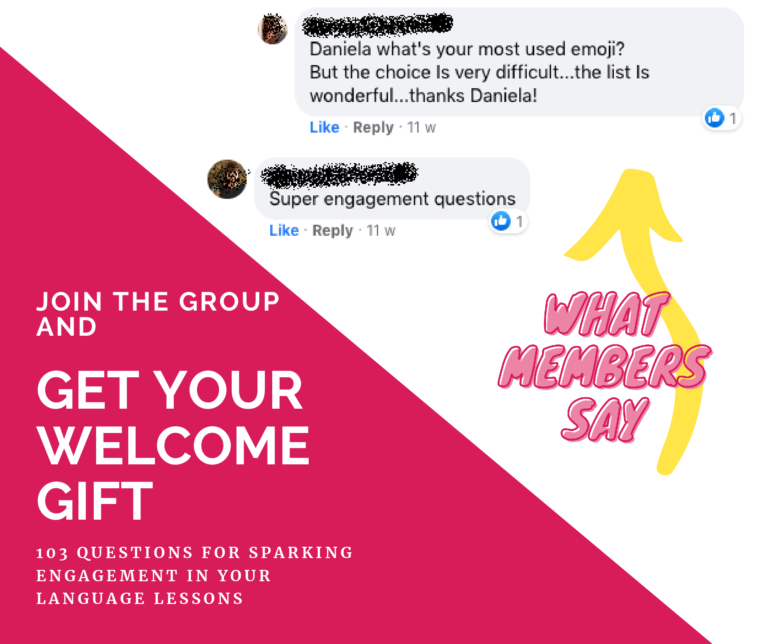
If you are a language teacher, a linguist or a language course creator, you certainly came across Suggestopedia. Maybe this method teased you, but you are not sure about how you could actually implement the suggestopedic method in your day-to-day teaching practice. Or maybe you are not sure about what the Suggestopedia method advantages and disadvantages are.
This blog post is dedicated to all my trainee language teachers and language course creators who are interested in Suggestopedia and want to answer one question: could this method be my cup of tea?
As a certified suggestopedic language teacher, I would like to fix this, possibly once for all. I see many sources talking and writing about Suggestopedia method advantages and disadvantages. What I condensed in this post is what I actually teach in my teachers training courses for linguists, language course creators and language teachers.
What is Suggestopedia?
In a nutshell, Suggestopedia is one of the very few methodologies recommended by UNESCO as a superior learning and teaching method. More precisely, it is a pedagogy: it has its own theoretical framework, its principles and its methodological guidelines for implementation. It was developed by Dr. Georgi Lozanov in Sofia (Bulgaria) starting from the late Fifties. More about this >>> here.
I had the honour to study with Dr. Lozanov. All my work as a language course creator is deeply influenced by Lozanov’s teachings.
The theoretical framework is based on 7 fundamental principles, also known as the 7 conditio sine qua non or 7 laws.
Those 7 principles and their pragmatic implications are so generative that, in my view, they can boost the efficacy of any type of teaching practice. In fact, although implementing some of the suggestopedic teachings won’t make you a suggestopedic teacher (I explain better this score below), it can certainly help you to get better results in the classroom.
What are Suggestopedia method advantages and disadvantages?
When we talk about Suggestopedia, we are talking about a very peculiar learning and teaching methodology.
Advantages:
- The first and biggest advantage is about the results. In fact, Suggestopedia speeds the acquisition process up by at least 6 times (up to 10 times, in many cases). This means people learn much faster and the acquisition is deeper compared to the acquisition process taking place with other methods.
- The amount of input students absorb during a suggestopedic course is much bigger compared to what they would acquire through other methods. This means people acquire more, in less time. The programme is dense. Suggestopedic teachers take beginner level students to the intermediate level in 72 hours.
- From the learners’ point of view, the acquisition process is a flow of enjoyable and playful activities, such as language games, music-based activities, dances and drama. Although the students are exposed to a huge amount of stimuli, they never feel under pressure, stressed or frustrated by this. The key point is that, in a suggestopedic lesson, students learn as smoothly as they did when they were little kids.
- No homework needed. This is another interesting feature. The acquisition process takes place during the classes only. The students don’t need to revise the lessons at home or to do homework.
- The method takes the students to absorb the target language and to become able to produce the target language in a creative and spontaneous way. During a classical, 72-hour, suggestopedic language course people absorb about 2,500 lexical units and can creatively put into use about 1,800 lexical units.
- It’s a good boost of self-confidence for the students! The whole learning experience is pleasant and enjoyable for the students involved. They learn a lot without effort and with joy. They link the learning of the target language with pleasant emotions and a joyful experience.
- It’s very creative and enjoyable to deliver! This comes from a teacher’s point of view J
Disadvantages:
I presented the following scores as disadvantages, although this really depends on the point of view. I will try to provide you with a broader view so that you can consider the disadvantages from different perspectives.
- The overall framework is intense and requires the teacher to necessarily stick to it. One of the main reasons why many suggestopedic teachers are not delivering so many courses is down to the fact they need to respect the original framework, which means delivering about 3.5 hours of lesson a day over a month. The main difficulty many teachers encounter is related to the students’ actual availability. In fact, the students are supposed to attend the classes 5 days a week (on average) for 3.5 hours a day over a month. That’s pretty intense and not everybody can give such availability nowadays.
- The teacher must take a specific training and get certified in Suggestopedia. In other words, this is not the kind of method you learn about from books.
- The quantity of materials a suggestopedic teacher needs to prepare is – oh my Goodness! – seriously BIG. I want to be honest with you: sometimes, when I get ready for my suggestopedic courses, I really feel overwhelmed. It takes me time to prepare everything I need: props, toys, exercises, activities, playlists, and so on.
- The training room should be a classroom specifically dedicated to the suggestopedic course. Also, it should be always the same during the whole course – no change of room whatsoever. Furthermore, it would be recommended to choose a welcoming room, looking more like a domestic living room, rather than a school classroom.
Well, we, suggestopedic teachers, do our best to stick to the classical guidelines we learnt in our training. Adaptations are allowed, though.
Final considerations
Before concluding this article, I would like to reframe the disadvantages by adding a few final considerations:
- This is the perfect framework for intensive language courses!
- Lozanov used to recommend to try different course patterns and to keep track of the achievements: if the results are comparable to those coming from the classical framework, then go for it and empower it.
- If you are not willing to get certified, Suggestopedia can help you anyway. I strongly believe that such rich and generative pedagogy can really have a huge impact in all teachers’ practice. This is part of my programmes for language course creators, linguists and language teachers. Although implementing some of the suggestopedic teachings won’t make your lessons properly “suggestopedic”, I think it can help you to get better results and to improve your teaching practice. I saw this so many times with my trainees!
- Yes, the amount of materials is big, but once it’s done you can use it for all your courses.
- I always do my best to keep the same classroom, but when I can’t I do my best to get the place ready for a suggestopedic experience. Just do your best!
Having touched the main scores about the Suggestopedia method advantages and disadvantages, I would like to leave you with 2 final thoughts.
For non-certified suggestopedic teachers
Even if you are not a certified suggestopedic teacher, who said you can’t improve, revamp, refresh your teaching practice thanks to a different perspective that Suggestopedia can provide you with?
I created the guide you can download below to help you in the implementation of some ideas coming from Suggestopedia. Check this out:
For certified suggestopedic teachers
Bear in mind Suggestopedia is bigger than the framework and that its teachings can really improve any other type of lessons and courses we do. We shall keep on experimenting schedules and patterns with an open mind.
Wrapping up
I hope this post about Suggestopedia method advantages and disadvantages gave you some clarity on what Suggestopedia is and if this can be your cup of tea.
Good luck!
Want more support?
Join the Facebook group Independent Language Teachers Collective to get daily advice, tons of free training and to branch out with other independent language teachers like you!
ALSO…
Available only for the Collective members: free list 103 question for sparking engagement in your language lessons.
This is what members say about the freebie:

Join in the Collective and grab your welcome gift:


